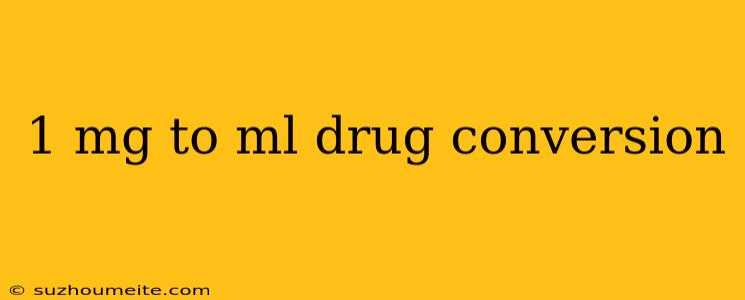1 mg to ml Drug Conversion: Understanding the Basics
When working with medications, it's crucial to understand the conversion between milligrams (mg) and milliliters (ml). This conversion is essential in pharmaceutical calculations, especially when preparing medications for administration. In this article, we will delve into the world of 1 mg to ml drug conversion and explore the principles behind it.
What is the difference between mg and ml?
Before diving into the conversion, it's essential to understand the difference between milligrams (mg) and milliliters (ml).
- Milligrams (mg): A unit of mass, primarily used to measure the weight of a substance, such as the active pharmaceutical ingredient (API) in a medication.
- Milliliters (ml): A unit of volume, used to measure the liquid volume of a substance, such as the liquid solution of a medication.
Converting mg to ml
To convert mg to ml, you need to know the concentration of the medication. The concentration is typically expressed in units of mg/ml. For example, if a medication has a concentration of 10 mg/ml, this means that 1 ml of the solution contains 10 mg of the active pharmaceutical ingredient.
The Formula
The formula to convert mg to ml is:
Volume (ml) = Dose (mg) / Concentration (mg/ml)
Where:
- Dose (mg): The desired dose of the medication in milligrams.
- Concentration (mg/ml): The concentration of the medication in milligrams per milliliter.
Examples
Let's consider a few examples to illustrate the conversion:
- Example 1: A medication has a concentration of 10 mg/ml, and you need to administer a dose of 20 mg. How many ml do you need?
Volume (ml) = 20 mg / 10 mg/ml = 2 ml
- Example 2: A medication has a concentration of 5 mg/ml, and you need to administer a dose of 15 mg. How many ml do you need?
Volume (ml) = 15 mg / 5 mg/ml = 3 ml
Conclusion
In conclusion, understanding the conversion between mg and ml is crucial in pharmaceutical calculations. By knowing the concentration of the medication and using the formula, you can accurately calculate the volume of the medication required for administration. Remember to always double-check your calculations to ensure accurate dosing.
Remember: Always consult the medication label or pharmaceutical resources for the concentration of the medication, and follow proper procedures for administration.
